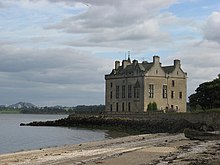John Mowbray of Barnbougle was a Scottish landowner and supporter of Mary, Queen of Scots. [1]

Family background
John Mowbray's father was born Robert Barton, a son of Robert Barton of Over Barnton, Comptroller of Scotland. He married an heiress, Barbara Mowbray, daughter of John Mowbray of Barnbougle, and took the surname Mowbray. He died in 1538. John Mowbray was a son of his second wife, Elizabeth Crawford. [2]
Career
John Mowbray's lands included Barnbougle Castle close to Cramond Island near Edinburgh. The surname is also written as "Moubray". French sources calls him the Sieur Bouquel and the Baron de Barnestrudgal.
Mowbray claimed a right to capture Portuguese ships according to old "Letters of Marque" granted to the Barton family and Andrew Barton. The rights were suppressed by the Parliament of Scotland in 1563. [3]
He was one of the jurors who acquitted the Earl of Bothwell of the murder of Lord Darnley.
After the "lang siege" of Edinburgh Castle, at the end of the Marian Civil War in August 1573, Mowbray presented a paper to Regent Morton with offers to save the life of his brother-in-law, William Kirkcaldy of Grange, including £20,000 worth of the jewels of Mary, Queen of Scots, remaining in her supporter's hands. [4]
Mowbray travelled to London and Paris and corresponded with Francis Walsingham. [5] Two of his daughters worked for Mary, Queen of Scots in England. [6]
According to a letter of the French diplomat Courcelles, [7] and Adam Blackwood's Le Mort de Royne d'Escosse, Mowbray went to London in October 1586 to plead with Elizabeth I for Mary's life and the release of Claude Nau and Curle. and after Mary's execution, to secure the release of her servants, including his daughters. [8]
Marriages and children
His wife, Elizabeth or Elspeth Kirkcaldy, [9] was a sister of William Kirkcaldy of Grange (died 1573). Their children included:
- Robert Mowbray. During the Marian Civil War, in 1572, Robert attempted to capture Dundas Castle. John Mowbray was imprisoned and Barnbougle was garrisoned by the King's party. Robert Mowbray sold Barnbougle to Thomas Hamilton, 1st Earl of Haddington in around 1614.
- Francis Mowbray (died 1593), an intriguer who offered to serve Mary, Queen of Scots, in 1580, and carried letters. [10]
- Agnes Mowbray, who married Robert Crichton of Eliock
- Elizabeth Mowbray, who married Archibald Napier of Merchiston and Edinbellie. They built Lauriston Castle.
- Marion Mowbray
- Barbara Mowbray (1556-1616), who married Gilbert Curle, a secretary of Mary, Queen of Scots. [11] She died in Antwerp. [12]
- Gillis Mowbray, who served Mary, Queen of Scots, and is said to have been the owner of the Penicuik Jewels. [13] [14]
External links
References
- ^ Mark Dilworth, 'The Curle-Mowbray family and the Scots College in Douai', Innes Review, 56:1 (Spring 2005), p. 12.
- ^ Accounts of the Treasurer of Scotland, vol. 7 (Edinburgh, 1907), p. 484.
- ^ Steve Murdoch, The Terror of the Seas?: Scottish Maritime Warfare, 1513-1713 (Brill, 2010), p. 85.
- ^ William Boyd, Calendar State Papers Scotland, vol. 4 (Edinburgh, 1905), p. 604 no. 712 (TNA SP 52/25 f.182).
- ^ William Boyd, Calendar State Papers Scotland, 1574-1581, vol. 5 (Edinburgh, 1907), p. 546 no. 632, 562 no. 637.
- ^ Mark Dilworth, 'The Curle-Mowbray family and the Scots College in Douai', Innes Review, 56:1 (Spring 2005), p. 12.
- ^ Sheila R. Richards, Secret Writing in the Public Records (HMSO, 1974), p. 40.
- ^ Mark Napier, Memoirs of the Marquis of Montrose (Edinburgh, 1834), p. 510.
- ^ John Hill Burton, Register of the Privy Council, vol. 2 (Edinburgh, 1878), p. 188.
- ^ William Boyd, Calendar State Papers Scotland, vol. 5 (Edinburgh, 1907), p. 562 no. 637: Edmund Lodge, Illustrations of British History, vol. 2 (London, 1791), p. 359.
- ^ William Boyd, Calendar State Papers Scotland, 1585-1586, vol. 8 (Edinburgh, 1914), pp. 135, 330.
- ^ Jos E. Vercruysse, 'A Scottish Jesuit from Antwerp: Hippolytus Curle', Innes Review, 61:2 (November 2010).
- ^ Rosalind Marshall & George Dalgleish, The Art of Jewellery in Scotland (Edinburgh, 1991), p. 14.
- ^ Walter Warren Seton, The Penicuik Jewels of Mary Queen of Scots (Philip Allan, 1923).